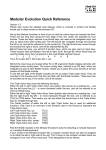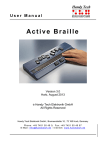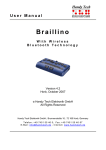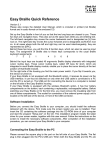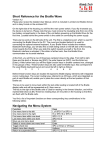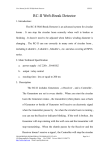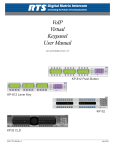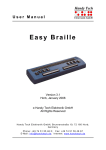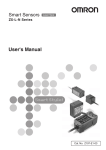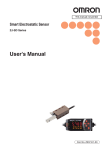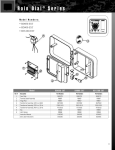Download Active Braille
Transcript
Short Reference for the Active Braille Version 1.0 Please also review the detailed User Manual, which is included in printed (not Braille) format and in daisy format on the enclosed CD. The two space bars are located at the centre front. In the following description the left space bar is called [SPCL] and the right space bar is called [SPCR]. If either the left or right space bar can be used they will be called [SPC]. Above the Braille display you can find 8 ergonomic function keys. These function keys are also used for Braille input. They correspond to the usual Braille keyboard layout and are, from the left to the right as follows: 7 3 2 1 4 5 6 8 Located in the middle of the device are 40 ergonomic Braille display elements with integrated cursor routing keys. The cursor routing (CR) keys which are integrated as part of each Braille cell enable you to place the cursor directly at the text position of this Braille cell. The Triple Action Keys are to the left and right of and flush with the Braille cells You can activate the Triple Action keys at the top, in the centre, and at the bottom. The Triple Action Key functions are: The left or right Triple Action Key's (Up) position also serves as a reading key to move backward within the text, and will be referred to as [TLU] or [TRU] in the list below. The left or right Triple Action Key's (Down) position also serves as a reading key to move forward through the text, and are referred to as [TLD] or [TRD] in the list below. In the event of the right as well as the left Triple Action Key (Up) can be pressed, it is called [TU]. If alternatively the Triple Action Key left or right (Down) can be used, this is called [TD]. In the case that you need to press both [TU] and [TD] simultaneously, such as setting a mark within the Editor, you may press the keys at the top left [TLU] and bottom right [TRD], or at bottom left [TLD] and top right [TRU]. The centre position of either the left or right Triple Action Key [TLC] and [TRC] can be used for additional functions. If you move along the right side of the housing towards the back, you will first feel the main power button. Located behind the power button is a USB type A port to connect a USB keyboard. Behind the USB type A port is the outlet for the power supply. On the left side of the device are from the front to the back – another USB type A port to connect a USB keyboard, a Micro SD card for service reasons and a USB type B port to connect a PC. Please do not remove the Micro SD card at any time from the device while it is on. Data on the card can be damaged. Please turn the Active Braille off, before you insert or remove the Micro SD card. Left on the back side you find a round headphone plug (2.5 mm) to connect a headphone or an external loudspeaker. The Active Braille is shipped with an adapter cable to connect also a 3.5 mm connector. You find a list of important functions an there corresponding key combinations in the following tables: Navigating the Menu System Function One menu item to the left One menu item to the right First menu item within one level Last menu item within one level Move up one menu level Select or move down one menu level Toggle check box Select menu item directly Return to suspended Editor Keys TU or SPC+7 or SPC+1 TD or SPC+8 or SPC+4 SPC+1 2 3 SPC+4 5 6 TLC TRC SPC or TRC or CR keys Hotkeys SPC+1 2 3 4 5 6 Editor Functions Function Abort operations, cancel markings Read text Start automatic reading Change automatic reading speed Manual scrolling Halt automatic reading Automatic scrolling via ATC on/off Delete character at cursor position Backspace Cursor to top of file (Home) Cursor to end of file (End) Cursor to beginning of line Cursor to end of line Cursor to beginning of next sentence Cursor to beginning of previous sentence Cursor to next word Cursor to previous word Move cursor left Move cursor right Move cursor one line up Move cursor one line down Direct cursor placement Mark beginning of block Cut block Copy block Delete block (without copying) Paste block Exchange mark and cursor Toggle insert/overstrike mode Set mark Jump to mark Incremental forward search Incremental backward search Forward search and replace Display character in ASCII Insert current date Insert current time Keys TLC TU or TD SPC+TD TU or TD, if automatic reading is active SPC CR keys Chord A (SPC + 1 7) SPC+4 5 Chord b (SPC+1 2) SPC+1 2 3 SPC+4 5 6 SPC+1 3 SPC+4 6 SPC+5 SPC+2 SPC+6 SPC+3 SPC+7 SPC+8 SPC+1 SPC+4 Cursor Routing Keys SPC+TRC or press CR key twice at beginning of block Chord x (SPC+1 3 4 6) Chord c (SPC+1 4) Chord X (SPC+1 3 4 6 7), or SPC+1 2 Chord v (SPC+1 2 3 6) SPC+7 8 Chord i (SPC+2 4), insert mode is default TU+TD Chord m (SPC+1 3 4) Chord f (SPC+1 2 4) Chord F (SPC+1 2 4 7) Chord r (SPC+1 2 3 5) Chord D (SPC+1 4 5 7) Chord d (SPC+1 4 5) Chord t (SPC+2 3 4 5) Function Save file (without closing it) Open file from Editor Open file in read-only mode Switch to next file Switch to previous file Save and close file Suspend Editor Editor's Setup menu Status display Switch to PC Mode Help Keys Chord s (SPC+2 3 4) Chord o (SPC+1 3 5) Chord O (SPC+1 3 5 7) SPC+5 6 8 SPC+2 3 7 Chord e (SPC+1 5) SPC+1 2 3 4 5 6 Chord u (SPC+1 3 6) Chord S (SPC+2 3 4 7) Chord p (SPC+1 2 3 4) Chord h (SPC+1 2 5) Keys in PC Mode Function Return to menu Switch between Braille display and status module display Keys Hold down SPC+1 3 4 about half a second SPCL+SPCR Fixed Key Functions on External Keyboard Function Switch external keyboard to PC Entire Braille display line to left Entire Braille display line to right Cursor to top of file Cursor to end of file Toggle between insert and overstrike Delete current character Delete character left of cursor Set beginning of block Copy block Cut block Delete block (without copying) Paste block Exchange mark and cursor Status display Incremental forward search Incremental backward search Forward search and replace ESC function Navigation Cursor to previous word Cursor to next word Cursor to previous sentence Cursor to next sentence Cursor to beginning of line Cursor to end of line Set mark Jump to mark Switch to next file Switch to previous file Suspend Editor Save file (without closing it) Key/Key Combinations Chord : (SPC+2 5) Page up Page down Ctrl+Pos1 Ctrl+End Insert Delete Backspace Ctrl+Enter Ctrl+c Ctrl+x Ctrl+X or backspace Ctrl+v Ctrl+Tab Ctrl+S Ctrl+f Ctrl+F Ctrl+r ESC Arrow keys Ctrl+cursor left Ctrl+cursor right Ctrl+cursor up Ctrl+cursor down Pos1 End Ctrl+M Ctrl+m ALT+Tab ALT+Shift+Tab Ctrl+Space Ctrl+s Function Save and close file Help Editor's Setup menu Switch to PC Mode Display character in ASCII Open file from Editor Open file in read-only mode Insert current date Insert current time Key/Key Combinations Ctrl+e Ctrl+h Ctrl+u Ctrl+p Ctrl+D Ctrl+o Ctrl+O Ctrl+d Ctrl+t Screen Reader Functions The key assignments for the different screen readers Window-Eyes, JAWS and Hal/SuperNova on the Active Braille are as similar as possible. In the following table, you find the assignments for Window-Eyes. You can find the tables for JAWS and Hal/SuperNova as well as the complete table for Window-Eyes in the user manual. Control Key/Braille Dot Function [7] Go to focus [3] Go to the active window's title bar [2] Toggle Braille tracking on/off [1] Move Braille display section one line up [SPCL] or [TU] Braille display section to the left [SPCR] or [TD] Braille display section to the right [4] Move Braille display section one line down [5] Toggle between Window-Eyes-cursor and mouse cursor [6] Go to the active window's status line [8] Drag mouse to focus [7 8] Specifies whether type of control element will be indicated or not [3 8] Toggle Browser Mode on/off [2 8] Toggle between 6/8 dot Braille [1 8] Handy Tech configuration dialog [4 8] Toggle blank spaces [5 8] Drag cursor to mouse [2 3] Beginning of line [5 6] End of line [6 8] Toggle Show Attributes on/off [1 2 3] Top of file [4 5 6] End of file [5 6 8] Run through attributes [TLC] Tab [TRC] Shift +Tab [SPC + 1 2 7] Toggle Braille input on/off [SPC + 1 7] ATC on/off [SPC + 1 2 3] ATC reading protocol on/off




